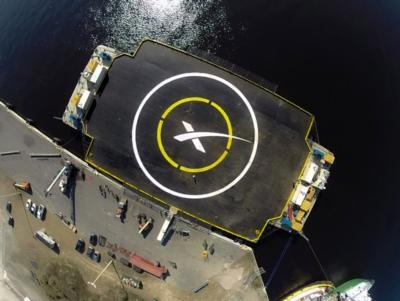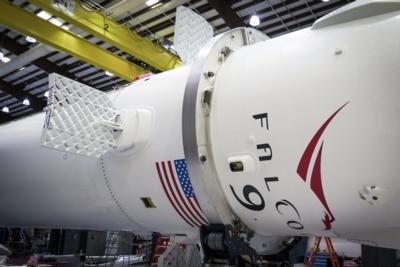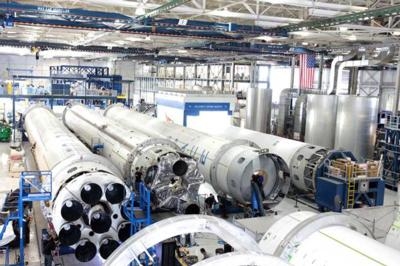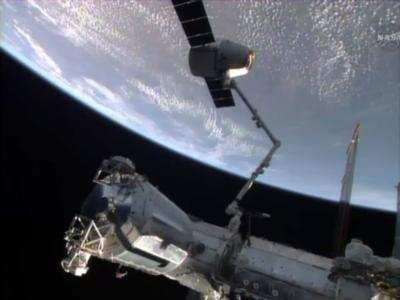If Tuesday Is A No-Go, Friday Is The Next Open Slot For An ISS Launch/Rendezvous
No one said the rocket business was easy... but it can be downright tedious when you have to contend with Mother Nature. The next launch of a SpaceX Falcon 9 to the ISS and the potential for their first landing of a robotically guided first stage at sea, could turn out to be a nail-biter.

Meteorologists were calling for a 60 percent chance of acceptable conditions early Tuesday morning, Jan. 6, for the launch of the SpaceX cargo resupply mission to the International Space Station. The primary concern lies with thick clouds expected to develop over the Florida launch site at Cape Canaveral Air Force Station adjacent to NASA’s Kennedy Space Center.
Launch time is 0620 EST. Period. Since this mission utilizes a tight 'Instantaneous' launch window (basically aiming for a one-shot trajectory as the ISS comes into proper position, without utilizing a lot of maneuvering resources), it has a second or so to go... or not.
The mission is the fifth cargo flight for SpaceX and will see the company’s Falcon 9 rocket lift a Dragon spacecraft into orbit loaded with more than 3,700 pounds of scientific experiments, technology demonstrations and supplies, including critical materials to support 256 science and research investigations that will take place on the station during the station’s Expeditions 42 and 43.

The most intriguing aspect of this launch is the fact that it may make history... though there is huge emphasis on the word, 'may.' SpaceX is expected to attempt the precision landing of a Falcon 9 first stage for the first time, on a custom-built ocean platform known as the autonomous spaceport drone ship. While SpaceX has already demonstrated two successful soft water landings (though the vehicle was lost in the ocean, as expected), executing a precision landing on an unanchored ocean platform is significantly more challenging.
The odds of success are not great—perhaps 50% at best. However this test represents the first in a series of similar tests that could ultimately deliver a fully reusable Falcon 9 first stage.
SpaceX notes that, "Returning anything from space is a challenge, but returning a Falcon 9 first stage for a precision landing presents a number of additional hurdles. At 14 stories tall and traveling upwards of 1300 m/s (nearly 1 mi/s), stabilizing the Falcon 9 first stage for reentry is like trying to balance a rubber broomstick on your hand in the middle of a wind storm."

"To help stabilize the stage and to reduce its speed, SpaceX relights the engines for a series of three burns. The first burn—the boostback burn—adjusts the impact point of the vehicle and is followed by the supersonic retro propulsion burn that, along with the drag of the atmosphere, slows the vehicle’s speed from 1300 m/s to about 250 m/s. The final burn is the landing burn, during which the legs deploy and the vehicle’s speed is further reduced to around 2 m/s."

SpaceX further warns that, "To complicate matters further, the landing site is limited in size and not entirely stationary. The autonomous spaceport drone ship is 300 by 100 feet, with wings that extend its width to 170 feet. While that may sound huge at first, to a Falcon 9 first stage coming from space, it seems very small. The legspan of the Falcon 9 first stage is about 70 feet and while the ship is equipped with powerful thrusters to help it stay in place, it is not actually anchored, so finding the bullseye becomes particularly tricky. During previous attempts, we could only expect a landing accuracy of within 10km. For this attempt, we’re targeting a landing accuracy of within 10 meters."
It'll be a heckuva feat if they pull it off, but with a number of other accomplishments to their credit, few are betting against the ultimate success of the SpaceX effort... though some 'oops' moments have occurred and are likely to still come up at any time. SpaceX promises that, "A fully and rapidly reusable rocket—which has never been done before—is the pivotal breakthrough needed to substantially reduce the cost of space access. While most rockets are designed to burn up on reentry, SpaceX is building rockets that not only withstand reentry, but also land safely on Earth to be refueled and fly again. Over the next year, SpaceX has at least a dozen launches planned with a number of additional testing opportunities. Given what we know today, we believe it is quite likely that with one of those flights we will not only be able to land a Falcon 9 first stage, but also re-fly."



 ANN's Daily Aero-Term (04.24.24): Runway Lead-in Light System
ANN's Daily Aero-Term (04.24.24): Runway Lead-in Light System ANN's Daily Aero-Linx (04.24.24)
ANN's Daily Aero-Linx (04.24.24) Aero-FAQ: Dave Juwel's Aviation Marketing Stories -- ITBOA BNITBOB
Aero-FAQ: Dave Juwel's Aviation Marketing Stories -- ITBOA BNITBOB Classic Aero-TV: Best Seat in The House -- 'Inside' The AeroShell Aerobatic Team
Classic Aero-TV: Best Seat in The House -- 'Inside' The AeroShell Aerobatic Team Airborne Affordable Flyers 04.18.24: CarbonCub UL, Fisher, Affordable Flyer Expo
Airborne Affordable Flyers 04.18.24: CarbonCub UL, Fisher, Affordable Flyer Expo









